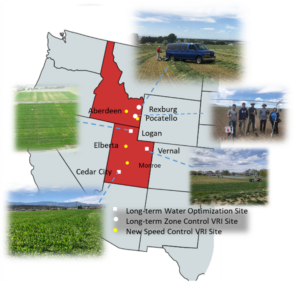Project Overview
Information Products
Commodities
- Agronomic: barley, corn, hay, medics/alfalfa, potatoes, sorghum sudangrass, triticale, wheat
Practices
- Crop Production: application rate management, conservation tillage, cover crops, crop rotation, cropping systems, drought tolerance, irrigation, no-till, varieties and cultivars, water management
- Education and Training: decision support system, demonstration, extension, on-farm/ranch research, workshop
- Energy: energy conservation/efficiency
- Soil Management: soil quality/health
Proposal abstract:
Concerns about water scarcity are mounting due to rapid urban growth, depleting groundwater supplies, and drought resulting from reduced and variable snowpack in the western United States. The mega drought of 2020-2021 compounded this problem for most of this region. Several areas of Idaho and Utah have frequent water shortages and droughts that cause about $95 million per year of loss. We propose Phase II of a long-term water optimization study to answer these two critical research questions: (1) Which combinations of irrigation and crop management practices result in optimal crop yield, crop profit, and water use efficiency? and (2) How can variable-rate irrigation become operational on production farms?
To address these research questions, we propose sustaining and expanding ongoing work to: i) conduct long-term experiments to identify how individual and ‘stacked’ water conservation practices (irrigation, crop genetics, and crop management) optimize water use and increase crop profit at three water optimization trials in Utah (Logan, Cedar City, and Vernal), and ii) continue long-term zone variable rate irrigation (VRI) research in Pocatello and Rexburg, Idaho and conduct four new on-farm trials in Idaho and Utah (Pocatello, Aberdeen, Elberta, and Richfield) to test and develop speed-control VRI. Results from these efforts will be the basis for an aggressive outreach and training effort reaching irrigators, irrigation suppliers, crop advisors, and conservation planners to improve knowledge and adoption of water optimization best practices. Dynamic outreach components will include interactive field days at the research sites, presentations and publications through Idaho and Utah Extension and professional associations, and a training event for irrigation advisors.
The anticipated project outcomes in the Western Region include:
- Over 300 stakeholders will engage in discussions and demonstrations of water conservation research at eight field days;
- Over 1,000 stakeholders will be educated on practices to optimize their water use during various Extension and professional presentations;
- Producers, agricultural professionals, and others will have access to timely information about practices that optimize water use through various Extension, farm press, and professional publications.
Producing and disseminating results on the suites of practices that economically and feasibly optimize water has and should continue to lead to greater acceptance and use of these practices. Results from Phase I of this work have shown that some combinations reduce irrigation use without impacting yield. We estimate that annual diversion of water could be reduced by 100,000’s of acre-feet if advanced practices were implemented by just half of the irrigators in Idaho and Utah. These outcomes would also assist producers and other stakeholders involved in proposing, creating, and administering cost-share or water bank programs to help optimize water use. Furthermore, we expect these trials will leverage the large foundation we have built during the last three years in Phase I of this project and provide valuable information concerning ideal short- and long-term water optimization strategies. This work has and should continue to spur further funding and support from the state and federal agencies where water conservation and optimization is a high priority.
Project objectives from proposal:
- Identify combinations of six water conservation practices (irrigation system and rate, coupled with crop type, crop genetics, cover crops, and tillage) with the greatest ability to optimize crop production, crop profit, and water use. Years 1-3.
- Demonstrate variable-rate irrigation systems that improve water and energy use efficiencies in long-term trials and on production farms. Years 1-3.
- Deliver dynamic educational products and training on water optimization through Extension and coordinated outreach to increase awareness and adoption of proven water optimization practices. Years 1-3.
